Diesel pushes Wrangler above mere icon
Filed under: Weekly test drives, Autos
By John Gilbert
It used to be that the arrival of a Jeep Wrangler to the Western tip of Lake Superior for a test drive promised equal parts adventure and nuisance. But the 2020 Jeep Wrangler Unlimited Sahara 4X4 has altered that dual description. It’s still adventurous, but the nuisance factor has been pretty well left in the dust and rubble by technology and refinement.
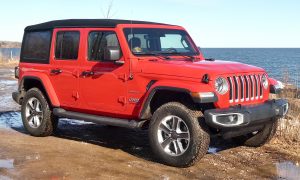
The test vehicle arrived in Firecracker Red paint that was so red that it was almost red-orange, bright enough to cause passers-by to take another look and to offer the occasional thumbs-up.
When automakers return to full production if and when this Coronavirus shutdown ends, it might be the perfect time to take a look into the expanding FCA line — which stands for Fiat Chrysler Automobiles, but also includes Jeep.
Especially Jeep.
The hearty all-American utility family was perhaps the prime jewel in the deal, when Fiat bought out Chrysler and all its appendages, and with Fiat’s enthusiasm behind it, Jeep has risen steadily in an industry climate that has been notably stagnant. As time has evolved, I found myself appreciating the Grand Cherokee and everything on down to the Renegade, always cautioning myself to not overlook the Wrangler — that rugged, war-born all-out utility vehicle that you can find climbing ridiculous obstacles wherever ridiculous obstacles can be found to drive over.
Then, a couple years ago, the Fiat-pushed refinement hit the Wrangler, adding various options to the suspension and drivetrain, coupled with some outstanding interior upgrades that have pretty much ruined Wrangler’s life-long reputation of being rugged and tough in all circumstances, even if it means being a little harsh to the uninitiated. That disclaimer is no longer needed, because the refinement has turned the rugged off-roader into an on-roader that is actually pleasant to drive, even on long trips.
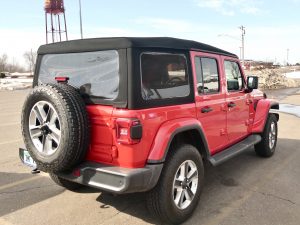
The biggest news about the new Wrangler is…well, it’s several things. First, the diesel engine is a 3.0-liter V6 turbodiesel, which FCA calls “EcoDiesel.” It is built in Italy, and the 8-speed automatic transmission handling the versatile 4-wheel-drive beast is made in Germany by ZF. The Wrangler itself is assembled in Toledo, Ohio. Talk about a citizen of the world.
The turbodiesel is not huge, at 3.0-liters, but it turns out huge power. It has 260 horsepower and a whopping 442 foot-pounds of torque. That allows the Wrangler to tow up to 3,500 pounds, which is a large haul for a tightly made 4-door Wrangler that still appears to be made to challenge rocks and hillsides off-road, where you wouldn’t be towing any trailers.
Beyond the powertrain, which shows EPA fuel estimates of 22 city and 29 miles per gallon highway, the diesel is quiet and hurls you off the line with quick power. The 8-speed shifted smoothly. The Wrangler now offers buyers a very difficult decision, coming with a tried and true 3.6-liter V6, or the outstanding new 2.0-liter turbo 4, or the turbo-diesel. Those fans who have had diesels know of their strength and durability, and won’t flinch at the option tag of $4,000 to add this Fiat-sourced 3-liter V6 turbodiesel, which is as quiet as the 3.6 gas V6 and about doubles the torque.
The suspension is heavy duty, with gas shocks, and the Command-Track part-time 4-wheel-drive system worked efficiently and without flinching. The part-time thing means you can shift it into 4×4 or 4-wheel-drive high, or 2-wheel-drive. In Minnesota, you’re still in 2WD most of the time if the highways are free of ice, but there aren’t many things more conducive to a secure feeling than to be in a Jeep with the system in 4WD, and the Dana front axle means it will also work over rough terrain, while hill-descent control will ease you down even the mile-high hills of Duluth, Minnesota.
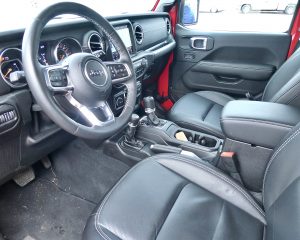
The interior’s straightforward and efficient instruments, its shift levers on the console, a navigation screen in easy view atop the center stack all are without criticism, but what sets the new Wrangler Sahara’s interior apart is the remarkably classy soft-leather front bucket seats, heated for the harshest weather and embossed with a Sahara logo.
With all the connectivity and satellite audio and remote-start capability, you look around and feel as though you’re in a typical 4-door SUV. It’s almost easy to forget that the roof you’re looking at is heavy-duty fabric, and you also can fasten a 3-piece fiberglass roof firmly in place, simply by sliding it out of its easily-stowed case. The fabric top was fine in some very chilly weather, and it left behind the recollection of flapping fabric tops on Jeeps from the old days.
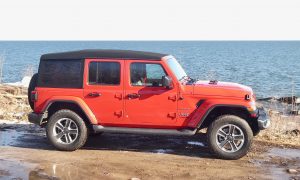
That is another old Jeep “tradition” that won’t be missed. Add in backup camera, and the safety security cross-traffic controls, and keyless entry and remote start puts this Jeep into its own realm.
But the most important thing is the overall package, which, when you combine all the high-tech features with the plush leather seats, make the Unlimited Sahara a vehicle that demands a comparison drive, even amid all those other Jeep models joining it in the showroom. Its base price of $38,645 quickly jumps to $55,925, diesel and all, but the lost tradition that will be missed the least is that after handling all sorts of rugged off-roading or even Duluth streets, it rides smoothly on the highways. No more 200-miles-on-a-pogo-stick treks for Wrangler lovers.
KEEP WATCH WITH SANDS
A month ago, I began a brief introductory if offbeat “test drive” that is certain to keep me on time. I have been selected to a trial run of a new Szanto ICON Roland Sands signature series wristwatch. This prize timepiece is designed to have the sporty flair of a motorcycle racer, which Sands was, in motocross and road racing, before he turned to designing motorcycles and accessories.

I’ve spent most of my career covering motorsports, with motorcycle road-racing among the highlights, everywhere from World Superbikes from Brainerd in Minnesota to Hockenheim in Germany on a very rainy weekend in 1989. So who better to evaluate a wristwatch designed by a bike racer?

Among his prizes are leather motorcycle jackets, which are hinted at in the leather ribbed bands of his watches. He helped with the actual design of the watch, itself, otherwise designed by Time Concepts, LLC., which has built outstanding Swiss watches. lt has a mineral crystal with 100-meter water resistance, a satin brushed stainless steel screw-on back, and a design that looks like the sort of watch a rider or racer might wear, both in the handlebar-like attachment bars and the watch face itself. It comes in assorted face colors and bands, starting at $225, and can be seen online at time concepts.net.
Corsair joins Lincoln SUV realm
Filed under: Weekly test drives, Autos, Uncategorized
By John Gilbert
Two or three years ago, if Ford Motor Company eliminated its luxury Lincoln brand we might not have been surprised, because only the king-sized Navigator seemed to be successful for Lincoln, and it was basically a Ford Expedition with bling.
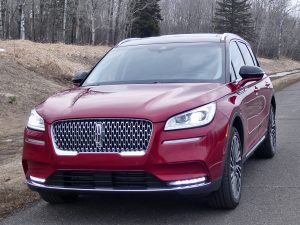
But in the space of one year, here we are evaluating — and praising — the third of three Lincoln SUVs all of which have carved out prominent places in the hierarchy of U.S. luxury sports-utility vehicles.
The new Navigator was deserving of high praise, and it was followed, barely a month ago, by a review of the entirely new Aviator, which I declared might be the best of U.S. luxury SUVs with its exceptional 3-row luxury as well as performance, tucked inside an extremely stylish exterior. And now, along comes the Corsair — Lincoln’s stylish example of what a compact, 2-row SUV can be, when a company puts its unrestricted mind to it.
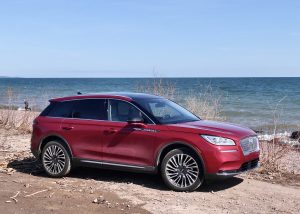
As someone who tries to be as objective as possible in evaluating any and all new vehicles, I had to admit the Navigator was bigger and heftier than I would choose, but its upscale luxury features made me realize why high-buck buyers would be drawn to it. The Aviator came wrapped in sheet metal that was attractively styled and the interior was loaded to the hilt with luxury pieces that made it expensive, but reasonably compact for a family that needed a 3-row SUV and still wanted something sporty and with surprising performance.
The Lincoln Corsair, on the other hand, fits like a glove my personal preferences for a compact SUV with adequate room for four or five and some baggage in its 2-row configuration, and it puts its tight and sleek styling to work in a sporty package that maneuvers easily, turns in a tight-circle u-turn, and will scat and run with the quickest of the compact SUVs. The competition is ferocious in the compact SUV realm, where Ford’s Escape is one of the standard bearers, and faces the likes of the Toyota RX4, Honda CR-V, Chevrolet Equinox, BMW X3 and numerous others, from virtually every manufacturer.
Since everybody seems to want an SUV these days, it makes sense that the majority of buyers might want to keep it compact when choosing, hoping to get improved fuel economy and making it easier to lure some performance out of smaller powertrains. The Corsair meets both ends of that bargain, delivering nearly 30 miles per gallon and still delivering some starch when you hit the gas.
Turbocharging is responsible for the compromise, with both Corsair engines, Ford’s 2.0 and 2.3-liter 4-cylinders gaining power from the forced-air feed of the turbos. The test-vehicle I drove was the loaded model, with a 2.3-liter turbo delivering a potent 295 horsepower and 310 foot-pounds of torque. That gives it about a one-second edge over the 2.0, with its 250 horses and 280 foot-pounds, in a 0-60 dash.
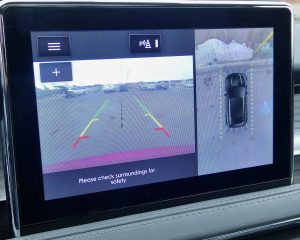
Taking a page out of Aviator’s book, the Corsair doesn’t have as flashy a dashboard design, but it does have similar bucket seats, with excellent support and 24-way power adjustability, with a curvaceous design that puts it up at the top of its class for comfort. The smooth leather seats have push-button heating and cooling ventilation, and add the therapeutic massage feature of its bigger siblings.
Lincolns have traditionally swiped the best features from Ford vehicles, and the Corsair wasn’t about to let the flashy new Escape get away with all its stuff, starting with its new and unique platform. The Corsair rides comfortably on the Escape chassis, which is firm in design which aids stability and sporty but safe handling. In its previous round of vehicles, Lincoln had the MKC sedan, which was nice, attractive, but was not an SUV.
The Corsair has the slightly taller stance and all-wheel drive, with all that high-end interior equipment and it is an SUV, retaining its flair for utility, even if compact and eye-catching.
One thing that takes a bit of getting used to is the shifter. Eliminating the console stalk to select gears gives occupants a bit more room, and Lincoln resists the temptation to go with the current and trendy norm of a rotating dial. Instead, on your first time inside and behind the wheel, you might spend a few minutes searching before you spot the location, just under the ledge of the center stack, where push buttons can activate reverse or drive or neutral to control the 8-speed automatic. Only problem, you can’t really see the buttons, so it helps if you know where they are.
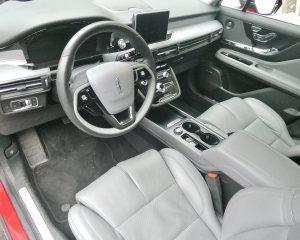
If the front buckets are supremely comfortable, and encapsulate you as if in a cocoon, the rear seats will slide to add to the quite roomy comfort in the rear. And it helps all the seats that the sunroof is one of those full, panoramic roofs that seems to open the whole ceiling to the outside.
Both models of the Corsair offer all-wheel drive, with the more basic model starting at about $39,000 and the upgraded Reserve model starting at almost $46,000. My test vehicle came loaded up with nearly $15,000 in optional equipment and packages, reaching over $62,000, which maintains its $6,000-$8,000 price status above the base model.
Among all those upgrades are some serious luxury touches, such as LED lights for added brightness in every application. Headlights, taillights and foglights are all LEDs, and it even has what are called approach lights, which give you a little lighted grid on the ground outside the doors to make sure you realize you’re getting into the right vehicle.
I’ve always been an advocate of getting the smallest vehicle that is big enough, and the Corsair is the perfect example of what I was getting at. It will do everything larger SUVs will do, but with the added convenience of agility and maneuverability in traffic and congested driving.
As for the styling, the Corsair has a lot of cues from the larger Aviator, with that distinctive Lincoln grille fitted in between the headlight fixtures, and a side view featuring contour lines blending into the sheet metal on both sides, and large, stylish alloy wheels, with dual exhausts. A nice added touch on the rear is a horizontal taillight that runs the full width of the vehicle and makes a distinctive impression on anyone approaching from the rear, or coming upon a parked Corsair.
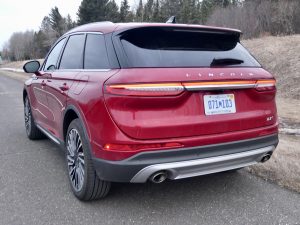
Built to slide, the rear seats offer comfort and added fold-down storage flexibility.
Maybe most people choose more compact SUVs because they cost less, but if things keep going the direction of the Corsair, we might have to start paying more to get all that styling into a smaller package.
Equinox gives Chevy a Premier compact SUV
Filed under: Weekly test drives, Features, Autos
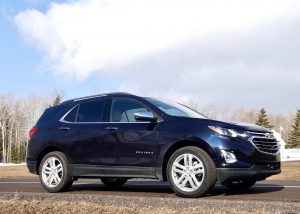
By John Gilbert
As the dreaded Coronavirus was about to foul up our springtime of 2020, I was just getting ready to enjoy the start of the NCHC college hockey playoffs, where the University of Minnesota Duluth was about to start its bid for a third straight NCAA title. I also had just finished a week-long road test with a 2020 Chevrolet Equinox Premier, a nicely styled and nicely sized SUV that is aimed at challenging the best of the compact SUVs — the RAV4, CR-V, Escape, Rogue, Cherokee, Tucson, Forester, and — my favorite — the Mazda CX-5.
Several things happened that caught me by surprise between my test drive week and the actual writing of this review. First, I was very impressed with everything about the Equinox, surprising because Chevrolet has seemed powerless to avoid fading away from the best of the rest. Second, I had read a couple reviews in car magazines, and my impressions of the previous Chevy SUVs and those test reports combined to make me apprehensive at best about the Equinox.
Another thing that happened was that the Federal Government has been very harsh — at least in its “Fearless Leader’s” dealings with General Motors. GM chief Mary Barra seems to have become one of President Trump’s favorite targets for his hit-and-run twitter/press briefing cheap-shots, dating back to his early days in office when he assumed all U.S. car-makers could simply shutter their overseas manufacturing plants and return to Detroit.
The most recent hit came after the last weekend in March, when the Coronavirus was tightening its deadly grip on all corners of the U.S., and Trump was live on television saying that GM had been dragging its feet when it came to aiding the nation, which was something he had become accustomed to in dealing with Barra.
It struck me as curious, because in the week before that outburst, I had read an account of how GM had worked out a partnership with Ventec Life Systems, a small company that makes ventilators, which have become so vital to helping afflicted patients keep breathing. GM engineers collaborated with Ventec on how they could convert a GM plant and find the materials to help Ventec make 10 times more than the 200 ventilators it normally makes each month.
In a matter of four days, the plan had been mobilized. And then Trump took his private little stage on Friday, March 27, 2020 and said he had activated an emergency plan that would force GM to help.
To their credit, although reportedly outraged, GM officials made the judicious move to keep on working around the clock to create ventilators without any comment on the accusation, and resisted making the link that Trump might have been hustling to attain his daily dose of praise, figuring if he hurried, he could take credit for forcing General Motors to start doing what it had already been doing for most of a week. Shortly after criticizing difficulties with GM “under Mary,” Trump cut off a daily press conference question about GM’s involvement and praised the company and its chairman for a “great job” of helping, stopping predictably short of apologizing for his awkward statement three days earlier.
Ford and FCA (Fiat Chrysler Automobiles), incidentally, also have been helping the cause. Ford, for example, has partnered with Minnesota’s 3M, and respirator-maker GE Healthcare, to simplify the process by which GE Healthcare can greatly increase its production of respirators, aiming at 100,000 per week.
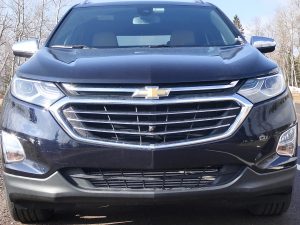
Meanwhile, back out on the road, I found the Equinox a far more worthy family hauler than a Motor Trend review of it indicated. Those car magazine hot-rodders tend to pound cars much harder than normal consumers might, so when they ripped the Equinox for not cornering like a Miata, I took it with a grain of salsa.
In testing a vehicle’s handling, what one driver might find too-soft in corner swaying is another driver’s comfortable ride; just like one driver’s firm and solid cornering might be another’s harsh and uncomfortable ride. The Equinox came in eighth and last in the Motor Trend comparison, but Chevrolet needn’t feel too bad; the magazine didn’t even bother to include a Ford Escape — another compact SUV I like a lot.
In the magazine’s test, the CR-V was first, the Mazda CX-5 second. Without question, the Equinox is no race car, although the magazine’s criticism of the car’s safety devices and poor-quality interior ingredients might be mostly due to the fact that it was not up to the standards of my test vehicle — which was the optional Premier, with its top-of-the-line features.
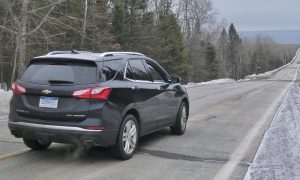
It was far better equipped to corner and display directional stability, and its numerous other interior and safety parts were much appreciated. The leather seats, lane-departure alert, lane-keep assist, rear-park assist and camera, heated and ventilated front buckets, heated steering wheel and adaptive cruise control are significant upgrades for a loaded, as-tested sticker of a reasonable $38,545.
Power in the test Equinox came from Chevrolet’s new-age 2.0-liter turbocharged 4-cylinder engine with a smooth-shifting 9-speed automatic transmission, while many competitors have a CVT (continuously variable transmission) that tends to drone and frustrate in equal parts. The 9-speed worked smoothly in coordination with the all-wheel drive in the Equinox.
The LED head and tail lights and the keyless start system are also nice things sometimes rare on compact SUVs.
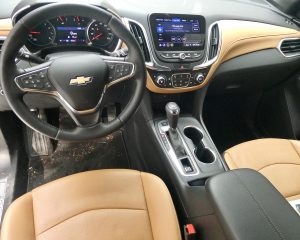
Each time I walked up to the Equinox, I was impressed by its styling, with its swept-back lines that blend the rear pillar into the rear of the vehicle. and I think it stands out from the pack because of that.
Chevy also makes the Traverse, which is a little bigger, but very similarly styled, with a V6 for power and three rows of seats. That makes it your choice: if you want and need a larger vehicle with a larger engine, or can get by with the agility of the smaller Equinox and appreciate improved economy. It was perfect timing that put the Equinox Premier with its push-button-activated all-wheel drive came into my hands at the precise time when it seemed that General Motors and Chevrolet needed and deserved some defending from unfair criticism from the White House, coupled with my impressions of the vehicle itself.
It has been a Chevrolet tradition when it makes cars to offer a top-of-the-line model, a mid-range model for features and expense, and a less-expensive bargain model that may be without a lot of appreciated features. Other companies cut corners similarly, but nobody else is guilty of stripping the true value items from its less-expensive models. That’s one area where the Japanese, Germans and Koreans are far ahead.
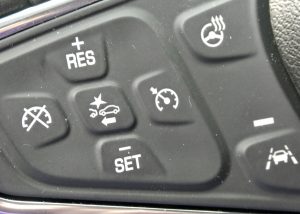
The Premier version of the Equinox matches most competitive compact SUVs, although the audio system was nothing special. It did have wireless charging for cell phones, and the optional OnStar system adds security. In its quest to load up remote switchgear on the steering wheel, though, I found that every time I cranked the steering wheel to get into or out of a parking spot, I inadvertently hit the little switch above the grip location and became conditioned to cancelling out the OnStar lady as she attempted to plan my rescue.
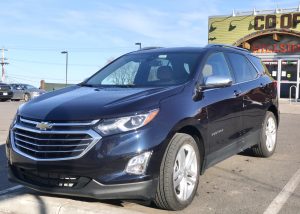
Over the weekend, various car dealerships hurting for sales came out with enormous ad campaigns. I caught a Chevrolet ad that screamed out about the 2020 Equinox being offered for 0-percent down, and 0-percent interest for 80 months, with the company paying the first four months-worth! That made the timing still better, because it seems as though Chevrolet is virtually giving away its Equinoxes.
Just remember, you may like it a lot or dislike it completely, but it all comes down to a driver’s opinion. And keep in mind that not all compact SUVs are created Equinox-ly.


 John Gilbert is a lifetime Minnesotan and career journalist, specializing in cars and sports during and since spending 30 years at the Minneapolis Tribune, now the Star Tribune. More recently, he has continued translating the high-tech world of autos and sharing his passionate insights as a freelance writer/photographer/broadcaster. A member of the prestigious North American Car and Truck of the Year jury since 1993. John can be heard Monday-Friday from 9-11am on 610 KDAL(www.kdal610.com) on the "John Gilbert Show," and writes a column in the Duluth Reader.
John Gilbert is a lifetime Minnesotan and career journalist, specializing in cars and sports during and since spending 30 years at the Minneapolis Tribune, now the Star Tribune. More recently, he has continued translating the high-tech world of autos and sharing his passionate insights as a freelance writer/photographer/broadcaster. A member of the prestigious North American Car and Truck of the Year jury since 1993. John can be heard Monday-Friday from 9-11am on 610 KDAL(www.kdal610.com) on the "John Gilbert Show," and writes a column in the Duluth Reader.